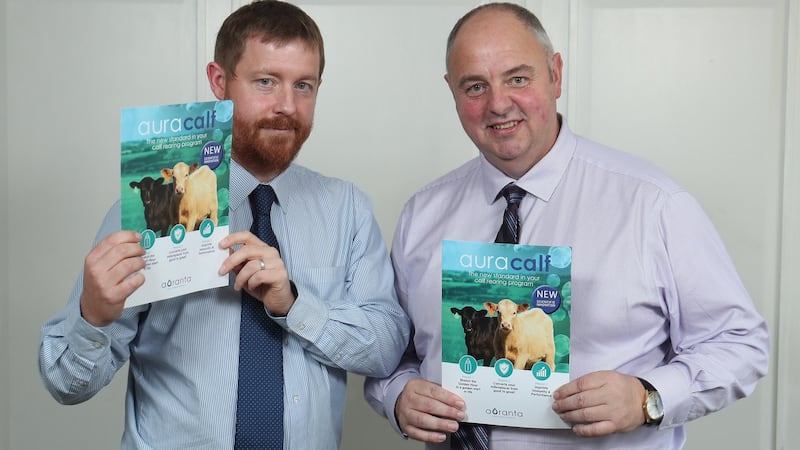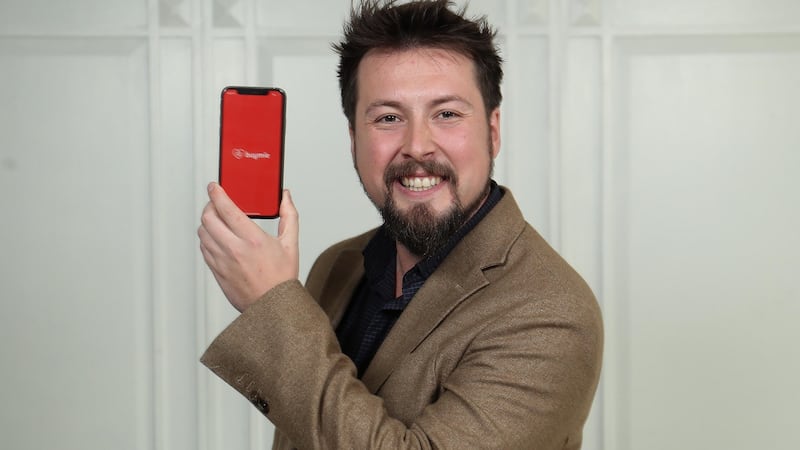Buymie app
– Winning the stomach share war
Consumers in the Dublin area may have noticed a new kid on the online grocery shopping block in the last year or so. The Buymie app allows customers to order grocery and household items from Lidl and Tesco and have their shopping delivered in as little as one hour by a personal Buymie shopper who works for them instead of the store.


Founder and chief executive Devan Hughes spotted an inefficiency in the market some years ago. "My background is not in the grocery or FMCG [fast-moving consumer goods] sectors," he explains. "I had a lot of experience in the energy market in operations and demand side management. Buymie is my fifth business. I had four spectacular failures behind me and in 2014 I got the itch to start out again."
He says he stumbled upon the grocery e-commerce market. "It is worth €9 billion annually in Britain and Ireland alone," he points out. "But the retailers involved make €300 million in losses every year because they are subsidising the delivery infrastructure. The distribution model they were using could never work. We have heat and power in our homes because the different services share the same infrastructure. There are nine grocery delivery distribution networks across Britain and Ireland all doing the same thing with a very costly duplication of infrastructure. The principles used for hundreds of years for the distribution of commodities were being ignored."
This sparked an idea. “It would be much different if they could share a single infrastructure. Look at the demand curve. The market is worth €9 billion now and is forecast to grow to €20 billion in 10 years’ time. If you have a rapidly expanding market with capacity issues you are going to have a correction. That’s economics and was my motivation to move into the space.”
He quit his job and went to work for Salesforce for a year to learn more about the area he was moving into. "In February 2016, exactly one year later, I quit and went full-time as Buymie's first full-time delivery person," he says.
"We had 1,800 downloads in the first few weeks," he recalls. "We started to scale and got a lot of press coverage. The market was in flux at the time. In late 2017 Amazon bought Whole Foods and became a major grocery player. Unilever acquired a stake in the company and became our first corporate investor."
Eamonn Quinn of the founding Superquinn family also came on board. "It started out as a mentorship relationship and he is now chairman of the company. He understands the pain points we are addressing."
In late 2018 Lidl became its first corporate partner. "We became the first company in Europe to bring a discount retailer online. We rolled out the service to their 37 stores in Dublin in just three months. We are now in every Lidl and Tesco store in Dublin. Customers choose where they want to shop, select their groceries, check out and pay with the app. The order is placed into the system and our shopper does the rest. It can be delivered in as little as an hour and the vast majority of orders are delivered the same day. That's where real demand is. With Deliveroo, Just Eats and so on all battling for share of stomach we are helping grocery retailers migrate to the online space."
There is also an AI dimension. "We call it Jarvis – just another rather intelligent system. It optimises the system by looking at things like weather conditions, traffic, shopper availability and so on, to optimises the delivery route. The shopper can also connect with the customer if products are out of stock or if a replacement is recommended."
Pricing is set at a competitive point, according to Hughes. “It’s between €3.99 and €6.99 plus between 9 per cent and 14 per cent of the bill depending on spend. Business is really good and the last 12 months have been transformational. Lidl really put us on the map in the last quarter of 2018. The business has grown twentyfold in the last 12 months. Right now, we are investing all earnings back into the business to scale and grow internationally. We have 16 full-time employees and expect to be profitable in the Dublin area within the next 18 months.”
CoastEye Mini-Buoy – Monitoring the marine environment
The CoastEye Mini-Buoy is a small, portable buoy which contains a number of sensors and can easily be deployed in coastal environments for a few months at a time to monitor the marine environment. The sensors connect back to the cloud-based CoastEye platform for data analysis, visualisation, processing and dissemination.
The Mini-Buoy and accompanying CoastEye platform were developed by Irish company TechWorks Marine which has been in the business of coastal monitoring technology for the past 15 years. “We are a marine technology company, but we are really more a marine data company,” says co-founder and chief executive Charoltte O’Kelly. “We make and integrate technology to gather information on the marine environment and we provide clients with live data.”
The company works for a range of clients in the public and private sectors including public bodies like Dublin Port. "We are supplying them with robust, reliable real time data from sensors in the marine data," says O'Kelly. "A lot of what we do is in the coastal zone area. Technically this extends to 50km from the shore, but we are mainly concerned with the zone from the shoreline to the horizon. We can help monitor the impact of water treatment plants, desalination plants, marinas, and so on."
She gives the example of dredging as a use for the technology. "Port authorities and other coastal zone users need real time information on the turbidity of water to comply with their permits. This is an indication of water quality."
But size is an issue. “When you put something on a boat, costs start spiralling out of control. A typical buoy is three metres wide, four-five metres tall and three-four metres below the surface. You need big trucks to move them around on land, you need big ships at sea, and you need big anchors.”
The company had been discussing the possibility of creating a smaller machine with the Environmental Protection Agency (EPA) and others. "We thought it would be cool if we had one that you could put in the boot of a car," she says. "We are talking about small, not miniature. It has to survive storms like Emma with 15-metre waves. The main difference with our large product is that she is quite small. She weighs 35-40kgs so it's like carrying a seven-year-old child. One person can easily carry it a short distance and two people can carry it quite far. You can plug in up to three sensors. In the future it will be four.
"All our competitors have one multiparameter sensor on their smaller buoy. Ours can take a multiparameter sensor but you can also plug in a current meter to see where the water is coming from and where it is going to. You can also add one to test for phosphate, nitrates or E.coli. This helps deal with issues like Ringsend and the E.coli problem there. It's a big scientific package with multiple data inputs."
And it can survive the harsh conditions to be found in Ireland’s coastal waters. “The EPA has had one in the water for six months.”
Its appeal is not limited to Ireland. "We are addressing a global market. Two-thirds of the world's megacities are situated in coastal areas and depend on coastal resources and they need to monitor those resources," O'Kelly notes. "We are at the Wetex trade show in Dubai at the moment demonstrating the Mini-Buoy is 40 degree Celsius water."
Development work on the Mini-Buoy started just 18 months ago. “We are now on the third iteration since the initial prototype and we are happy that it is a commercial product,” she says. “We are currently developing a sales implementation plan for it. Marine monitoring is not a mass market business and production will be in the tens rather than hundreds or thousands.”
The development process has been very important. “You have to get it right. We had to make sure that it is useful for coastal zone regions and users of coastal zones. It provides them with data they can use to help them carry out their day-to-day activities. We have a huge resource called the ocean which covers 70 per cent of the globe. Ireland is very privileged to be an island nation with a small population. Ireland should be developing marine technologies and exporting them to the world.”
Auranta
– Boosting the animal immune system
Dublin-based Auranta has developed a range of animal feed additives which boost the immune system, reduce the need for antibiotics, and significantly reduce mortality. Not only do the additives improve the health of new-born and very young animals, they also enhance their performance in terms of weight gain and other key parameters throughout their lives.
The complementary animal feed products are produced from plant extracts and are designed for calves, poultry and pigs, under the AuraCalf, AuraPoultry and AuraShield brands.
Auranta managing director John Cullen explains the innovation by referring to AuraCalf. “What we do is produce animal feed additives,” he says. “Dairy calves are weaned off milk after a couple of days and put on a milk replacer. Using our additives in the replacer boosts the animal’s gut health. The animal’s immune system is developed in the gut and how the animal performs over its life is directly related to the early development of the immune system.
“A dairy calf is hugely dependent on what happens in the first few months of its life,” he adds. “How much milk it will produce is directly related to its health during the first two months. Scour and other infections will decide future performance. There is a lot of research to prove that. Our products are aimed at those first few months and go into very young animals.”
He explains that the microbiome, the bacteria that inhabit the gut, is unique to every animal. “It’s like a fingerprint,” he says. “But when the animal is born there is nothing there. The gut gets colonised after birth.”
It is this period of colonisation during which the microbiome is programmed for life that the Auranta product range targets. “Our additives are a bit like probiotics, but they are not intended to kill anything. They protect the animal by giving a boost to the immune system. Most other products on the market try to mimic medication by killing pathogens in the gut but their ingredients kill good bacteria as well as bad.”
The Auranta products are far more selective, however. They deal with the pathogens while protecting the good bacteria. The mechanism is quite complex but involves action on the gut wall which prevents the pathogens from attaching to it. “We allow them go through and do no harm, but we don’t do anything to stop the production of good bacteria.”
This also helps reduce the use of antibiotics. “There is nothing wrong with antibiotics,” says Cullen. “They are among the greatest discoveries in human history. But they can cause problems if they are overused. New legislation is coming in at the end of 2021 and farmers will not be allowed to use antibiotics to prevent infection or promote growth from them. At the moment, companies like McDonald’s and KFC don’t want antibiotics in the meat they buy.”
Work started on the additives back in 2013. “We had been looking at natural extracts from plants to improve the shelf life of food products and it wasn’t too long before we started to look at nutritional products. We met with animal nutritionists and vets in the Far East and started looking at ideas for the animal feed area in 2014 and 2015. The lightbulb moment for us was when we found we could go in and just deal with the pathogens while keeping as many good bacteria alive as possible.”
That saw the company begin work with Prof Nicolae Corcionivoschi of the Agriculture Food Biotech Institute in Belfast. “He is a global expert in the animal microbiome and through him and our work with a group of Thai vets we started developing and testing products. We then carried out research to show what they were actually doing. Once we had the results we developed a product for use in animals.”
AuraCalf was launched in 2018 and is now selling in eight markets with distributors appointed in 10 more and discussions ongoing with distributors in eight other countries.
“Business is very good,” says Cullen. “Sales have doubled over the past year. Every penny we make goes back into product development. When we started out, we didn’t have hard data to convince people we weren’t mad. Now that we have that data things are going very well. The calf product will do very well next year and we plan to introduce the poultry [product] in the Far East next year. We have some new products and enhancements in the pipeline, but we are going to stick to the knitting and build on what we have first.”














